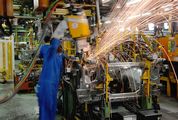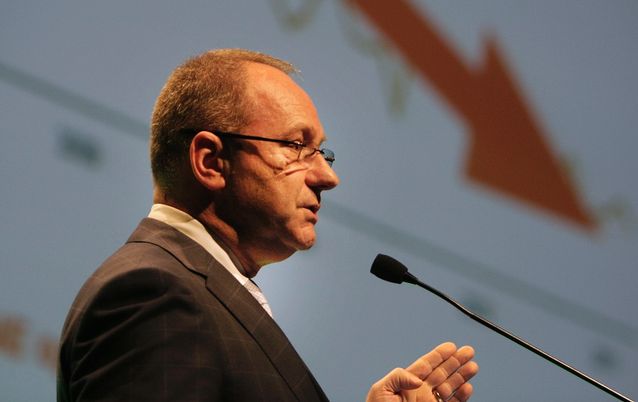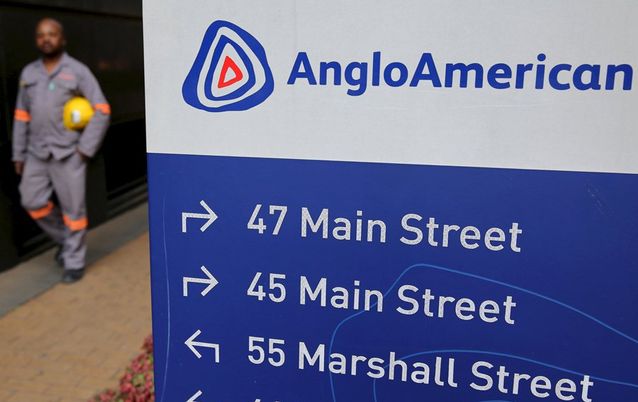THE high-profile presence of mining giant Anglo American at this year’s Mining Indaba in Cape Town raised eyebrows, as many other cash-strapped miners opted to skirt an event that has become increasingly expensive.
"It sent the wrong message," an Indaba delegate said. "It didn’t feel like a company that is going through dramatic restructuring."
Still, CEO Mark Cutifani rationalised it like this: "SA accounts for 40% of our earnings and we have a commitment to the country and to government, which is keen to see our presence at Mining Indaba."
This is especially so, Cutifani said, given that the company’s portfolio still includes Anglo Platinum, the coal division and Kumba Iron Ore.
"We have halved our costs at Indaba year on year. We have taken 30% out of corporate overhead costs and there is more to be done. Our overhead ratios are among the lowest in the industry," he says.
But if anyone was unconvinced about Cutifani’s desire to slash costs, they’d have been surprised by his February 16 announcement of a much harsher cost-cutting and asset sale programme than ever before at the company.
It was dramatic news, sparking an initial drop in the share price, before a resounding 8% gain on the JSE the day afterwards as investors began to compute the value likely to be unlocked by these sales.
But it caps a miserable time for the 99-year-old mining giant, which, to many, has been synonymous with South African entrepreneurship. Last year, Anglo had the unenviable distinction of being the worst performer on the London Stock Exchange’s FTSE-100. And, from March, if its market cap falls too low, it will be dropped entirely when the index is rebalanced.
Hanré Rossouw, a portfolio manager at Investec Asset Management (IAM), says this would have "more of a psychological effect on shareholders than a direct effect on the share price. Selling by index tracker funds would have only a minor effect."
Rossouw describes Anglo’s track record on mergers and acquisitions as "dismal", citing the building of Minas-Rio, the unbundling of Mondi (which has since grown to a larger market capitalisation than Anglo), the timing of the purchase of the Oppenheimers’ stake in De Beers and the increase in its stakes in Anglo Platinum and Kumba.
"Consistently over the past 15 years, Anglo has misread cycles and procrastinated on taking decisive action," Rossouw says.
Cutifani was brought in to steady the ship in 2013, but he sailed directly into a storm.
"Anglo has in the past rejected approaches from predators, preferring to be defensive and internally focused. It might be a sad way to celebrate the centennial anniversary of this once proud company in 2017, but if breaking up Anglo would deliver shareholder value, then it should be considered."
At a market capitalisation of R128.7bn just after its year-end results were released, the value of Anglo American on the JSE was only slightly higher than that of Bidvest, and one-sixth the value of media giant Naspers.
Cutifani’s bold new plan is an effort to change this trajectory, going back to basics.
For investors, it’s a straight equation: the difficulty of delivering this asset sale programme, seen against the value that can be squeezed out of the sales.
Among the assets that Anglo American is putting up for sale are well-managed businesses which, in the past, delivered excellent returns when the cycle was favourable.
They include Kumba Iron Ore, as well as the Grosvenor and Moranbah metallurgical coal mines in Australia and Anglo’s share of Cerrejon thermal coal in Colombia.
Other assets that are up for sale are niobium and phosphate (in which Mick Davis’s X2 Resources could be interested, it is speculated), followed by nickel and Australian thermal and metallurgical coal mines.
Selling Kumba may be the hardest task. Anglo still holds 69.7%, and, based on Kumba’s share price of R65, Anglo’s stake is worth about R14bn. This is why Anglo says it is looking at "various options" for Kumba, including a spin-off.
To some, the Minas-Rio project in Brazil has been the biggest albatross around Anglo’s neck in recent times, sucking much-needed capital away. But Cutifani says Anglo is committed to completing it. "We will then review our options, depending on the market and the progress we have made. We are not announcing a sale today but are saying it is noncore."
When it comes to selling its South African coal mines, Cutifani says Anglo has run an open tender for those mines and held discussions with government and Eskom, to which they are a major supplier.
Anglo has "plenty of room to negotiate value. If we cannot get the right value immediately, we will take time to do so."
The plan is to raise between US$3bn and $4bn from disposals this year, which will allow it to bring its net debt down to $10bn by the end of this year, from $12.9bn at the end of December.
In the medium term, Anglo wants to cut its net debt to about $6bn. By the end of this year, Anglo expects to be free cash flow positive.
Debt is one of the key reasons for Anglo’s weak share price.
Analysts say this is why Anglo’s share price has shed 65% over the past three years, worse than most of its rivals, and the opposite trajectory of the JSE’s all share index, which grew 21% in that time.
The plan will have a sharp impact on employment, though. Of its 128,000 employees, 68,000 jobs will be shed through disposals and another 10,000 through cost savings and internal efficiencies, bringing Anglo’s global workforce down to 50,000.
The reform plan also entails cutting capital expenditure, which fell to $4bn in the past year and is forecast to fall to $3bn this year and $2.5bn next year.
Once the slashing, selling and reforming are all done, there’ll be a new-look Anglo. And this much slimmer version will retain its exposure to commodities and assets in which it has a leading position: copper, diamonds and platinum.
As it stands, Anglo American Platinum is the world’s biggest platinum miner and it is keeping its most cost-competitive mines, which produce commodities geared towards consumer spending.
In diamonds, De Beers has a globally unassailable position, with far better quality production than its nearest rival, Alrosa of Russia, and marketing expertise built up over 100 years.
Though both diamonds and platinum have weakened of late, both should recover as consumer spending on cars and jewellery picks up and China focuses on a more consumer-driven economy.
In copper, Anglo American owns two of the world’s biggest mines, at Colluhuasi and Los Bronces in South America. Copper producers have found it very difficult to deliver on ambitious expansion plans and structural deficits in copper are forecast for the medium term.
However, copper will give Anglo American continuing exposure to infrastructure development, which will resume when emerging economies in Africa and Asia find stability.
Rossouw says the focus of the "new look" Anglo, on consumer commodities, makes strategic sense. IAM has for some time favoured companies exposed to consumer spending and avoided iron ore and coal producers.
And yet, there was nothing in Anglo’s latest announcement to persuade IAM to change its "underweight" position on the stock — partly because Anglo is likely to face challenges in executing its strategy.
This is no exaggeration. Anglo is embarking on one of the biggest disposal programmes this year, and its ability to sell assets at a time when many others are selling is limited. Billiton and Glencore have already delivered on their asset sales.
Assuming all the sales happen, however, Shoaib Vayej, portfolio manager at Afena Capital, says Anglo’s focus on just three commodities means it will no longer be a truly diversified resources group.
Vayej is in favour of a complete break-up of Anglo because individual assets would operate better without the costs and interventions of the Anglo head office.
It’s common knowledge that Anglo has made some poor capital allocation decisions in recent years — especially buying assets at the top of the cycle.
The company has then managed to squeeze some value out of the assets it sold, but this has always taken longer than expected — Tarmac, for example. Had it acted sooner, it might have got better prices.
Though Anglo began cutting costs before some of its peers, the fact that it took so long means others are now doing the same. Vayej says this lowers the cost curve across the industry, putting prices under further pressure.
Shortly before its February announcement, ratings agency Moody’s Investors Services cut Anglo’s credit rating to junk status.
Moody’s says Anglo’s risks have increased largely because of deteriorating market conditions. But it adds that Anglo’s goal of cutting debt will take longer and be more difficult than previously expected.
Moody’s doesn’t expect Anglo to be able to reduce its debt significantly within the next two years.
Cutifani’s response is heated.
"We have dropped 20 assets already, far more than anyone else in the industry, and ahead of schedule. We expect to dispose of another 10 by midyear. We look as if we will end our first phase programme six months early, delivering all we said we would," he says.
He also points to the company’s other achievements since he took the CEO chair, just less than two years ago.
"In my first full two years in the role we have seen a 60% reduction in safety incidents, a 70% reduction in environmental incidents and a 10% increase in production across the group — despite closing or selling 30% of the assets.
"We have seen an increase in production per person of 27% and a $1bn cut in capital projects that were committed before my time and delivered on schedule," he says.
Still, the biggest influence on Anglo’s shares is the mining cycle — and here, timing is everything.
Consider this fact: investors who bought Anglo’s stock at R141 on the JSE in early 2009 would have more than doubled their money had they sold within two years.
However, any investors who bought the shares in mid-2000 at R84 and held for 16 years would have seen no capital gain by mid-February this year, though they have benefited from a steady stream of dividends.
Though Billiton and Rio Tinto also made poorly timed, costly acquisitions, Anglo’s shares have been hit far harder than theirs.
Those who bought BHP Billiton shares in mid-2000, at R25 each, were still showing a sixfold gain to R150 (plus R13.51 on the unbundled South32) in the same period. Like Anglo, BHP’s stock has fallen to less than half its 2014 peak.
Billiton shareholders enjoyed continuous progressive dividends, however, even if there is talk that Billiton will not be able to maintain this dividend policy in the current environment.
Perhaps Anglo’s biggest mistake was its $14bn investment in the Minas-Rio iron ore mine, pipeline and port project in Brazil. Minas-Rio came on stream only in late 2014 — just as the iron ore boom was tapering off.
The others made blunders too: BHP Billiton’s $4.7bn purchase of shale gas assets in the US in 2011 was similarly poorly timed and Rio Tinto’s $38bn takeover of aluminium producer Alcan in 2007 was even more costly.
Says Rossouw: "Anglo’s shares underperformed BHP Billiton and Rio Tinto in the upcycle not because of negative perceptions towards its South African exposure but because Anglo lacked iron ore exposure when iron ore prices were running strongly."
So is there still value left in Anglo?
Analysts think so.
What is clear is that even after Anglo shrinks to a copper, platinum and diamonds company, it will still offer South Africans a rand hedge, with global reach, valuable commodities and depth of experience in mining.
JPMorgan, which has an underweight recommendation on the shares, has said it sees value in Anglo over the long term, but this depends on a recovery in commodities prices in the medium term.
Though commodities prices firmed in the first two months of this year, analysts doubt there will be a major turnaround anytime soon.
Afena Capital points out that last year, global GDP growth fell into a recession, when measured in dollars.
But Vayej says there is the potential for "short-term relief for commodities, based on reversal of the 2015 trend and the fact that dollar strength has probably peaked and the carry trade is reversing."
Over the longer term, however, there’s no getting around the fact that demand for commodities must improve for prices to really shift into another gear.
"Attention has focused on China, but its data remains negative, and it is difficult to trust the figures.
"A broader recovery is needed from emerging markets, which are more resource intensive, and as there are no signs of that yet, it continues to put downward pressure on commodities prices," he says.
Moody’s negativity extends beyond Anglo American.
It believes "the current environment is not a normal cyclical downturn, but a fundamental shift in the operating environment for the global mining sector".
As a result, Moody’s is reviewing all its ratings in the mining industry.
"With the downturn likely to be deeper and longer than previously anticipated, the rating agency believes that price risk remains to the downside, given global economic uncertainties and slowing growth in China," it says.
The good news for Anglo’s long-suffering shareholders is that Cutifani’s strategy is not based on an optimistic outlook for the prices of commodities.
The Australian mining veteran told the Mining Indaba that this year looked like the most challenging yet and things "may still get worse".
This is probably why he won’t commit to any specific date for the resumption of dividends.
On this point, Cutifani says: "I would like to think we will have the debt under control at the end of the year. We will need another year, in 2017, to get it right down to target.
"The earliest possible date to resume dividends would be 2018 but it is the board’s call."
Still, investors with the courage to buy "when there’s blood on the streets" may want to buy into Anglo American now.
The more risk-averse should wait for certainty on an upturn for commodities.
























